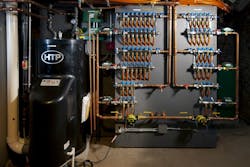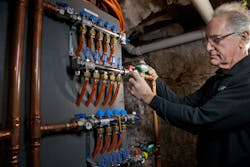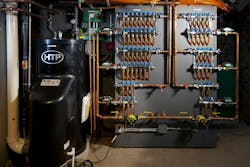Efficiency is immune to the law of gravity
HANOVER, MASS. — Despite the harsh winter in the Northeast, one Massachusetts family was the coziest they’ve ever been following a much-needed mechanical overhaul. And, what’s best, said the homeowner: they watched in satisfaction as their energy bills fell to levels they’ve never seen. Their home — a 4,500-sq.ft., farmhouse built in the1850s on Boston’s South Shore — came with its own piece of history.
“It’s known locally as the ‘Anchor Homestead,’ ” said Christian Frattasio, with manufacturer’s rep firm, Emerson Swan. “For the seven generations, the original homeowners — the Beal family — used it as the clan’s anchor. No matter how far and wide family members were cast during various eras of American progress, they always came home several times a year to maintain close ties.”
The property is not only rich with New England heritage, but also hydronic history. Originally equipped with a big gravity hot water system (once as common as clam chowder in these parts), then later retrofitted into a forced hot water behemoth some 40 years ago, the old 220 MBH cast iron machine was ready for replacement.
In the years since the first conversion, several mechanical skirmishes were waged upon it, always in an attempt to tame the old system. Some worked, others didn’t. At one point, the gravity arrangement was abandoned, but its big, fat piping wasn’t. Under-powered circulators struggled to move water through a network of pipes that varied precariously in size from two inches to three-quarters of an inch diameter.
The fluid raced though baseboard, then slammed into massive cast-iron radiators. According to the homeowners, some rooms were suitable for slow-roasting a Thanksgiving turkey, while others were better suited for storing frozen birds. The system barely kept the plumbing safe and the occupants miserable.
When Rich Swatton, president of ModCon Service and Support Inc., based in Westford, Mass., first laid eyes on the home in Hanover, Mass., he called it like he saw it.
“It was a flow problem, and a big one, at that,” said Swatton. “The circulators couldn’t move the water sufficiently, let alone with any accuracy to the places that needed it most for winter comfort.”
ModCon is a four-man crew of hydronic masterminds — all of whom shares a passion for the craft. They split their efforts evenly between residential and commercial work. As the name implies, servicing modulating-condensing boilers is the firm’s primary focus. In their down-time, they install systems like the ones they service.
Divide and conquer
Months ago, when they left the farm house after the initial visit, the ModCon crew already had a pretty good idea of what the new system would look like after the overhaul.
“When properly designed, cast iron emitter systems work incredibly well,” said Swatton. “The problem is distribution and circulation — and we know how to handle that.” He knew the key to success would be dividing the big, single loop of the home into numerous, independent zones.
The 29 radiators needed to be isolated, each with their own flow rates. With a mix of large, vertical radiators, convection radiators, and cast-iron baseboard, there was no one-size-fits-all flow rate that would accommodate each application of heat. The heat emitters were broken into six zones, each guarded with a 1-in. Taco Zone Sentry zone valve.
“To isolate the radiators, we installed dedicated supply and return units to each one,” said Swatton. “But first, the old steel pipe had to come out; all of it.” During the first few days of the fall 2012 retrofit, every reciprocating saw that ModCon owns was put to work. All hands on deck toiled to remove the heavy sections of black pipe.
They hauled it down steep, narrow stairs, dug it out of dirt-floor crawl spaces, and pitched it out of windows. More often than not, the pipe had to be cut to shorter lengths, inevitably making cleanup a chore.
“At times, we had trouble finding all the feeds and returns,” said Swatton. “Some were pretty well hidden.”
In place of the old pipe, 3,000 feet of half-inch Watts RadiantImproving on improvement
Once the supply and return piping was completed, and each radiator was isolated, the secret to the flow rate problem came in the form of smart circulators and pre-manufactured, variable manifolds. Six stainless steel Watts Radiant Flowmeter manifolds allowed each of the 29 loops to be individually adjusted for the perfect flow rate.
To best capitalize on the variation that the manifolds provide, two variable-speed, ECM, Taco BumbleBee circulators were installed; each one provides flow for one level of the home via three manifolds. The Delta-T pumps supply the perfect amount of water, regardless of how many or which zones are calling.
“Using the BumbleBee in its Delta-T mode helped simplify the system by guaranteeing my actual design delta across the zones,” explained Swatton. “It matches flow output with heat loss, providing the high level of comfort and energy efficiency I demand on my jobs. The way we have it programmed, the pump is going to be searching for a 30°F Delta-T.”
Additionally, Swatton prescribed reverse return piping to distribute the flows and pressures more evenly across the system, inherently making it more balanced.
Modulating-condensing, naturally
“We’ve grown to love the Flowmeter manifold, especially for the numerous radiant retrofits we do,” said Swatton. “It lent itself perfectly to this job, especially with a variable speed pump, which ramps up and down according to the exact amount of flow we need at any given time. Since we’ve been in business, we’ve always specified Taco pumps, not only because the Delta-T design fits well, but because they’re American made and stand behind their product.”
To get maximum benefit from high-tech pumps and the perfected distribution piping, Swatton wasn’t about to finish the system without their namesake trademark. A 160 MBH, modulating-condensing HTP Pioneer boiler is installed in the basement close to the shiny manifolds and yellow pumps. According to Swatton, he wanted to use a boiler with a large water jacket. At 55 gallons, the Pioneer makes it easy to supply micro-zones without short cycling the unit.
The five-to-one turndown boiler is factory-equipped with an outdoor reset, making sure supply water temperature is correct, regardless of what’s going on outdoors. It also eliminates temperature spikes in the radiators.
“If the outdoor ambient temp is 10°F, then our supply temp is roughly 160°F,” explained Swatton. “If it’s 60°F outside, we can drop back to 90°F or 100°F supply.”
“Regardless of what supply temperature the boiler is putting out, “said Frattasio, “domestic hot water has priority. The boiler will ramp up to provide 180°F for the water heater.” A 119-gallon indirect-fired tank insures the four-person family won’t run out of water, even if the boiler is running full-tilt to heat the home.
"This is a classic New England retrofit, using products manufactured in America, designed specifically for the uniqueness of our systems,” he continued. “There are so many noisy, inefficient, old systems throughout the Northeast. What we’ve essentially done here is to create a template for anyone who wants the best of both worlds: energy efficiency and the aesthetic appeal of their old cast iron radiators.”
Proof of the pudding
“When we first bought the home, we tried to keep the temperature comfortable — on average — despite the hot and cold rooms,” said Seth, the homeowner. “After a month of that, the gas bill came in at $1,100. Needless to say, an extra blanket went on the beds, while house slippers and sweatshirts became standard dress around the house. By turning the heat down toward 60°F, we kept the house from freezing, and dropped the gas bill to $700 per month.”
“Now, after the retrofit, our average winter gas bill is in the $500s,” continued Seth. “You could say that the savings are in the 50% range, but that’s not counting the huge comfort improvement of the home. I don’t really know how to attach a dollar sign to that.”


